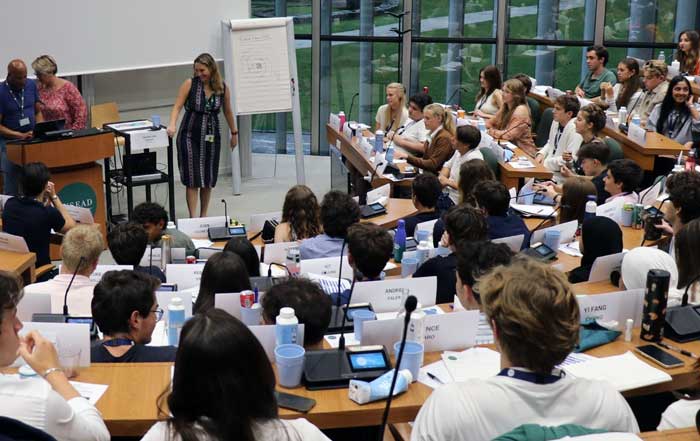In the ever-evolving landscape of higher education, selecting an institution for studying business is a decision that carries profound implications for a student’s career trajectory, professional network, and intellectual foundation. For tradeprofession.com, which serves an audience deeply interested in Business, Investment, Technology, Innovation, Global, Education, and adjacent verticals like Artificial Intelligence and Economy, this article seeks to present a definitive guide to the top 20 universities and colleges globally for business disciplines in 2025. The aim is not merely to list names, but to provide a thoughtful, expert-informed, and strategic lens through which prospective students, business leaders, and institutional stakeholders may evaluate their choices.
This article proceeds as follows: first, it outlines the criteria and methodology one should adopt when judging business education; next, it presents a curated list of 20 leading institutions with distinctive strengths; and finally it offers comparative analysis, recommendations, and strategic considerations for stakeholders. Where relevant, the article links to internal tradeprofession.com pages (e.g. business, education, global, innovation) and high-quality external sources for deeper exploration.
Criteria: How “Top” Is Judged in Business Education
Any ranking, however carefully devised, must be understood in light of its underlying criteria and what those imply. The selection here reflects a holistic judgment across multiple domains of performance, including:
Academic reputation and research output. Beyond prestige, businesses value institutions that generate influential thought leadership, rigorous research, and scholarly contributions in business, economics, management, and adjacent fields.
Faculty quality & industry engagement. Strong faculties with a mix of academic and practitioner ties, advisory board roles, and consulting engagements help tether curriculum to real-world challenges.
Alumni outcomes & employability. A critical metric: how many graduates secure top-tier roles, leadership positions, entrepreneurial success, or board seats. Salary progression and career mobility matter.
Curriculum innovation, globalization & interdisciplinarity. Leading schools embed digital transformation, sustainability, AI, global strategy, and cross-disciplinary collaboration into their programs.
Network, brand, and partnerships. Where an institution links to global firms, multinationals, governments, NGOs, and offers exchange programs, its students enjoy privileged access.
Cost, value, and accessibility. In 2025, with tuition inflation and student debt concerns, return on investment (ROI) and scholarship access are crucial.
Diversity, equity, sustainability, and social impact. The modern business curriculum cannot ignore ESG, inclusive leadership, and systemic risk; institutions rising in 2025 are those integrating social responsibilities into core offerings.
These criteria align closely with the themes of tradeprofession.com’s audience—especially those engaged in innovation, sustainable, executive, founders, and global perspectives.
Before presenting the list, a caveat: different rankings (e.g. QS, FT, Times Higher Education) emphasize different weightings (MBA vs. broader business subject, research vs reputation). The following list blends subject rankings in business & management as well as MBA program excellence.
🎓 Top 20 Business Schools 2025
Explore leading institutions by region and specialization
The Top 20 Institutions for Business Education in 2025
Below is a curated list of 20 universities and colleges globally that stand out in business and management education. The list is not strictly ranked by number; rather, it is organized to showcase diversity of geography, model, and special strength.
1. University of Pennsylvania – The Wharton School (USA)
The Wharton School at the University of Pennsylvania continues to assert dominance in global business education through its research output, alumni network, and deep specializations in finance, quant management, and AI-embedded decision sciences. Research.com lists Penn as the top institution in its Business & Management rankings based on academic influence and researcher affiliation. Wharton graduates often land roles in hedge funds, PE, fintech, and strategy at elite firms, and the school’s focus on global immersion, analytics, and entrepreneurship keeps it at the forefront of innovation. For those interested in finance, investment, technology, Wharton remains a perennial first option.
2. Stanford Graduate School of Business (USA)
Stanford GSB dominates not just in brand recognition but in alignment with Silicon Valley’s entrepreneurial ethos. Its programs emphasize design thinking, AI-driven strategy, and venture creation. In 2025, Bloomberg Businessweek has ranked Stanford as number one for its MBA, praising its strength in networking, learning, and compensation metrics. Stanford is especially compelling for students aiming for roles in startups, venture capital, or technology leadership—particularly in the AI and innovation sectors.
3. Harvard Business School (USA)
Harvard’s global brand is unmatched. Its case-method pedagogy, executive network, and alumni reach across global boards and governments give it enduring prestige. In 2025, HBS still commands tremendous influence among C-suite executives and policymakers. It may not always top salary-based rankings (given high cost of living and tuition), but its brand and network deliver outsized long-term returns for many students.
4. Massachusetts Institute of Technology (MIT Sloan) (USA)
MIT Sloan’s strength lies in the seamless integration of technology, analytics, and business strategy. It is widely recognized for embedding artificial intelligence, machine learning, and operations research directly into its core MBA and master’s offerings. In 2025, MIT continues to rank near the top in business and economics subjects in the Times Higher Education subject rankings. Its close ties with engineering and computer science make it a go-to for students who want to straddle tech and business.
5. INSEAD (France / Singapore / Abu Dhabi)
INSEAD is often lauded as the most “international” business school in the world. It operates campuses in Europe, Asia, and the Middle East, and admits rich diversity to its accelerated MBA (10-month format). In the QS World University Rankings by Subject, INSEAD is among the top in Europe for business & management. Its focus on global strategy, cross-border management, and multilingual cohorts is one of its chief differentiators.
6. London Business School (UK)
London Business School (LBS) combines location advantage—access to London’s financial hub—with rigorous academic programs. Many students leverage internships and corporate ties in global firms. LBS is a key node in Europe’s business education network, and for students seeking roles in finance, consulting, or corporate leadership in Europe, LBS is often among the first recommendations.
7. IESE Business School (Spain)
IESE (University of Navarra) in Spain has steadily earned global acclaim. In the 2025 Financial Times Global MBA Ranking, IESE holds the third position, making it the highest-ranked European MBA program in many assessments. IESE’s curriculum emphasizes ethics, leadership, corporate social responsibility, and a humanistic approach to business. It offers strong international mobility—students rotate across campuses and continents.
8. SDA Bocconi (Italy)
SDA Bocconi combines European prestige with specialization in management, economics, and finance. Its MBA and master’s programs are known for strength in strategy, sustainability, luxury business, and digital transformation. In many European rankings, SDA Bocconi competes tightly with Scandinavian and UK institutions. Its alignment with European business culture and quality of life in Milan also give it appeal to global candidates.
9. HEC Paris (France)
HEC Paris consistently ranks among Europe’s very best. With interdisciplinary strength in management, entrepreneurship, and luxury/consumer business, it attracts a diverse cohort. HEC’s alumni extend across EU leadership, multinationals, and venture sectors. Its strong partnerships with international corporations deliver internship pipelines.
10. University of Oxford (Saïd Business School) (UK)
Saïd Business School, Oxford University’s business school, benefits from Oxford’s centuries of reputation and academic rigour. Its executive and MBA offerings tend to emphasize global public-private synergies, social entrepreneurship, and high-level policy engagement. Oxford’s prestige broadens the appeal of its business credentials beyond pure profit-driven domains, which is especially relevant for students interested in public policy, ESG, and sustainable business.
11. University of Cambridge (Judge Business School) (UK)
Judge Business School at Cambridge leans heavily on research, angel investment communities (given the Cambridge tech cluster), and integration with STEM. A student who wishes to navigate the boundary between biotech, deep tech, and business would find Cambridge’s ecosystem compelling. Cambridge also provides strong access to UK and EU academic networks.
12. University of Chicago Booth (USA)
Chicago Booth is distinctive for its quantitative rigor, economics-anchored approach, and strong finance tradition. Its faculty includes Nobel laureates and particularly deep strength in economics, econometrics, and behavioral science. For students seeking to specialize in data-driven financial analytics, structuring, or economic policy, Booth remains a top-tier choice.
13. Columbia Business School (USA)
Columbia benefits from its New York location and access to finance, media, and global business. It emphasizes urban leadership, sustainable finance, and digital innovation. In the 2025 FT Global MBA ranking, Columbia is second, reinforcing its global competitiveness. Many students use the proximity to Wall Street for internships and recruitment.
14. Northwestern University Kellogg School of Management (USA)
Kellogg is especially strong in marketing, strategy, and organizational behavior. Its collaborative culture and emphasis on team-based projects distinguish it. Kellogg’s recent ranking shifts in 2025 reflect improved metrics in student learning and recruitment. It remains a favorite for those focused on brand, consumer strategy, and leadership roles that require strong soft skills.
15. University of Toronto Rotman (Canada)
In North America outside the U.S., Rotman School of Management in Toronto is frequently cited as Canada’s top business school. It combines strong research, consultative pedagogy, and ties to global firms in banking, consulting, and tech. Rotman is also noteworthy for attracting a diverse international student body, which helps connect Canadian business education to global markets.
16. London School of Economics and Political Science (LSE) – Department of Management (UK)
Although not a standalone business school, LSE’s Department of Management is globally respected for business & management education as part of a broader social sciences institution. LSE students benefit from the university’s reputation in economics, political science, and social policy, enabling integrated perspectives on business and society. The institution ranks highly in QS subject rankings for business & management studies.
17. National University of Singapore (NUS) Business School (Singapore)
As Asia’s economic hub continues to evolve, NUS Business School rises in prominence. It blends Western methodologies with Asian commercial insight, preparing graduates for roles in the dynamic Asian markets. In the QS ranking for business & management subjects, NUS has improved its standing, and its pan-Asian exchange programs and corporate partnerships make it a top choice for Asia-focused students.
18. University of Melbourne (Melbourne Business School) (Australia)
Melbourne Business School is among the highest-rated in the Asia-Pacific region and globally respected for its research, teaching quality, and executive education. Australia’s strategic location between East and West, plus robust industry engagement in mining, finance, and agribusiness, gives MBS a solid niche in global business training.
19. University of Hong Kong (HKU Business School) (Hong Kong, China)
HKU Business School blends an international reputation with strategic access to Greater China’s markets. It emphasizes finance, strategy, fintech, and entrepreneurship tied to the Asian corridor. Through collaborations and Hong Kong’s status as a global financial center, HKU offers appeal to students wanting to navigate China, ASEAN, and global linkages.
20. Indian Institute of Management, Bangalore (IIM Bangalore) (India)
Though not a Western institution, IIM Bangalore has gained global recognition, particularly in Asia. In recent assessments, it ranks among Asia’s top 3 in Bloomberg’s business school rankings, underscoring its rising footprint. For students interested in emerging markets, digital finance, or South Asia’s growth story, IIM Bangalore strikes a compelling balance between affordability, regional relevance, and quality.
Comparative Insights and Strategic Considerations
Geographic Diversity & Strategic Fit
The above list is intentionally geographic in diversity: North America, Europe, Asia, and Australia are all represented. For a student, the decision often comes down less to prestige and more to strategic alignment:
A candidate wanting to work in finance in New York or London may prioritize Wharton, Booth, Columbia, or LBS.
A student aiming for tech entrepreneurship, AI, or Silicon Valley might lean toward Stanford, MIT Sloan, or Harvard.
For those targeting emerging markets, Asia, or ASEAN roles, institutions like NUS, HKU, IIM Bangalore offer distinct advantages in networks and market insight.
In Europe, INSEAD, IESE, HEC Paris, LBS, Oxford, Cambridge offer exceptional mobility and connections across the EU and global corridors.
Thus, the “best” is contextual to one’s intended career geography.
ROI, Cost, and Scholarship Considerations
Prestige carries high tuition costs and living expenses (especially in the U.S. and U.K.). Prospective students must weigh:
Scholarship availability. Many top schools reserve generous fellowships, especially for underrepresented or international candidates.
Post-graduation salary vs debt burden. Some schools may require 10 years to break even; others in lower-cost regions may offer faster returns.
Internship and employer relationships. Schools in financial capitals or tech hubs justify cost by proximity to opportunities.
Programs, Curriculum Specialization & Innovation
In 2025, the differentiators increasingly lie not in broad business fundamentals, but in specialization:
Business analytics, AI, and machine learning are embedded in many top programs (especially at MIT, Stanford, Wharton).
Sustainability and ESG: business schools like IESE, HEC, and Saïd integrate impact and responsibility deeply into core curriculum.
Entrepreneurship & innovation labs are must-haves in modern business schools. Those that tie startup incubators, venture capital, and corporate innovation centers stand out.
Shorter formats & modular learning: institutions like INSEAD and IMD leverage accelerated formats for global career shifters.
Because tradeprofession.com readers are deeply interested in sectors like AI, technology, innovation, and global strategy, the strength of a curriculum in these advanced domains is a key differentiator.
Reputation, Network, and Brand Momentum
Brand momentum remains powerful in business schools. Alumni networks, board memberships, and executive placements feed back into institutional prestige. Many recruiting firms filter first by school brand, then by candidate credentials. That said, disruptive startups and new entrants are gradually debunking this—some students may do better by leaning into specialization and niche networks.
Evolution Post-2025
As of 2025, several trends accelerate:
Greater acceptance of hybrid and online MBA models—especially for mid-career executives.
Short executive certificate tracks in AI, blockchain, sustainable finance are gaining credence.
Regional hubs (e.g. Southeast Asia, Africa) may spawn high-potential institutions that compete for local talent.
Thus, some students will judiciously prefer emerging top-tier regional schools over legacy institutions.
Recommendations for Prospective Students, Executives & Institutions
For Prospective Students
Match mission with specialization: Don’t aim for prestige alone. If your ambition is to found a fintech in Southeast Asia, a school strong in digital business ecosystems and regional connectivity may trump global brand.
Vet curriculum for AI, ESG, and digital disruption: Given the evolving business environment, ensure the program you choose is not stuck in 20th-century business thinking.
Embrace global mobility: Choose programs with exchange, global residencies, or modules in multiple countries—critical for cross-border careers.
Network strategically: Leverage alumni, mentors, and industry partnerships as much as classroom credentials.
Plan finances carefully: Seek fellowships, industry sponsorships, or employer support. Understand ROI in your target market.
For Executives & Institutional Leaders
For companies recruiting MBA or business school graduates, and for educators shaping programs:
Cultivate partnerships: Engage the institutions listed above in research, case development, and executive programs, reinforcing a pipeline of talent.
Co-design curricula that reflect industry challenges in AI, climate risk, supply chains, and platform business models.
Sponsor students, fellowships, or chairs in emerging fields, to build downstream recruitment advantage.
Leverage internal innovation labs to collaborate with student teams on real problems, enhancing authenticity of student learning and talent scouting.
For tradeprofession.com
Given tradeprofession.com’s domain focus, this article serves as both valuable reference and content pillar in the education, global, business, innovation, technology, and executive verticals. Internal links bolster SEO relevance for these sections:
For coverage of how artificial intelligence is integrated into these institutions, readers may explore the site’s Artificial Intelligence section at tradeprofession.com/artificialintelligence.html.
To understand implications for global business strategy and mobility, refer to tradeprofession.com/global.html.
To align with readers focused on innovation and entrepreneurial ecosystems, see tradeprofession.com/innovation.html.
For those interested in overlaying these trends on the economy and macro shifts, refer to tradeprofession.com/economy.html.
For individuals considering founders and startup journeys, this list could help in identifying alliances and talent sources consistent with tradeprofession.com/founders.html.
By anchoring content in tradeprofession.com’s domain verticals, this article strengthens both internal coherence and external visibility.
Closing Reflections
In 2025, the landscape of business education is both more accessible and more competitive than ever. A decade ago, reputation and prestige would almost alone decide the “top” business schools. Today, the differentiators increasingly reside in high-value specialization, innovation, global nimbleness, social impact, AI literacy, and cost-effectiveness.
The 20 institutions spotlighted here represent the vanguard of business education globally. Yet each student or executive must navigate that list with purpose, mapping their career goals, financial reality, and preferred region of impact.
For tradeprofession.com and its audience—drawn to business, technology, investment, global, education, and innovation—this list serves as both reference and provocation: to think strategically about where the next generation of business leaders is forged, and how partnerships among institutions, firms, and thought platforms can amplify impact in the decades ahead.









